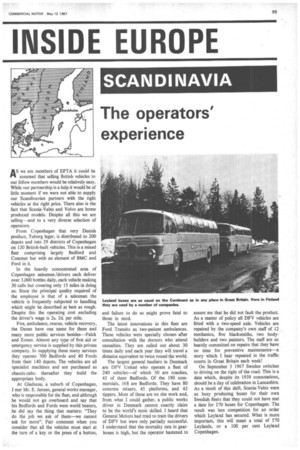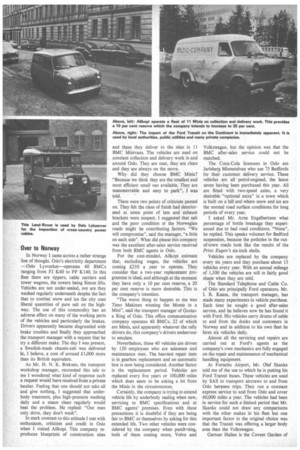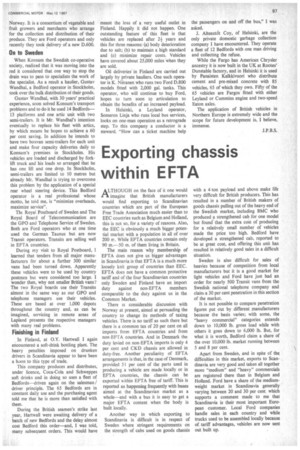INSIDE EUROPE
Page 97

Page 98

Page 99

If you've noticed an error in this article please click here to report it so we can fix it.
AS we are members of EFTA it could be assumed that selling British vehicles to our fellow members would he relatively easy. While our partnership is a help it would be of little moment if we were not able to supply our Scandinavian partners with the right vehicles at the right price. There also is the fact that Scania-Vabis and Volvo are home produced models. Despite all this we are
selling and to a very diverse selection of operators.
From Copenhagen that very Danish product, Tuborg lager, is distributed to 200 depots and into 29 districts of Copenhagen on 120 British-built vehicles. This is a mixed fleet comprising largely Bedford and Commer but with an element of BMC and Ford in it.
In the heavily concentrated area of Copenhagen salesmen /drivers each deliver over 3,000 bottles daily, each vehicle making 30 calls but covering only 15 miles in doing so. Since the principal quality required of the employee is that of a salesman the vehicle is frequently subjected to handling which might be described at best as rough. Despite this the operating cost excluding the driver's wage is 2s. 2d. per mile.
Fire, ambulance, rescue, vehicle recovery, the Danes have one name for these and many more public services besides—Falck and Zonen. Almost any type of first aid or emergency service is supplied by this private company. In supplying these many services they operate 700 Bedfords and 40 Fords from their 140 depots. The vehicles are all specialist machines and are purchased as chassis-cabs: thereafter they build the appropriate body.
At Gladsaxe, a suburb of Copenhagen, I met Mr. F. Jensen, general works manager, who is responsible for the fleet, and although he would not go overboard and say that his Bedfords and Fords were world beaters, he did say the thing that matters: "They do the job we ask of them—we cannot ask for more". Fair comment when you consider that all the vehicles must start at the turn of a key or the press of a button,
and failure. to do so might prove fatal to those in need.
The latest innovations in this fleet are Ford Transits as two-patient ambulances. These vehicles were specially chosen after consultation with the doctors who attend casualties. They are called out about 30 times daily and each year they will travel a distance equivalent to twice round the world.
The largest general hauliers in Denmark are DFV United who operate a fleet of 240 vehicles—of which 50 are coaches, 45 of them Bedfords. Of the 190 commercials, 168 are Bedfords. They have 80 concrete mixers, 45 platforms, and 43 tippers. Most of these are on site work and, from what I could gather, a public works driver in Denmark .cannot exactly claim to be the world's moit skilled. I heard that General Motors had tried to train the drivers of DFV but were only partially successful. I understand that the mortality rate in gearboxes is high, but the operator hastened to
assure me that he did not fault the product. As a matter of policy all DFV vehicles are fitted with a two-speed axle. Vehicles are repaired by the company's own staff of 12 . mechanics, five blacksmiths, two bodybuilders and two painters. The staff are so heavily committed on repairs that they have no time for preventive maintenance a story which I hear repeated in the traffic courts in Great Britain each week!
On September 3 1967 Sweden switches to driving on the right of the road. This is a date which, despite its 1939 connotations, should be a day of celebration in Lancashire. As a result of this shift, Scania-Vabis were so busy producing buses for their own Swedish fleets that they could not have met a date for 270 buses for Copenhagen. The result was less competition for an order which Leyland has secured. What is more important, this will mean a total of 570 Leylands, or a 100 per cent Leyland Copenhagen.
Over to Norway
In Norway I came across a rather strange line of thought. Oslo's electricity department —Oslo Lysverker—operates 40 BMCs ranging from FJ K40 to FF K140. In this fleet there are tippers, cable carriers and tower wagons, the towers being Simon lifts. Vehicles are not under-sealed, nor are they washed regularly underneath despite the fact that to combat snow and ice the city uses liberal quantities of pure salt on the highway. The use of this commodity has an adverse effect on many of the working parts of the vehicles and particularly the brakes. Drivers apparently became disgruntled with brake troubles and finally they approached the transport manager with a request that he try a different make. The day I was present, a Swedish-made chassis-cab was delivered 'at, I believe, a cost of around £1,000 more than its British equivalent.
As Mr. H. N. K. Breksen, the transport workshop manager, recounted this tale to me I wondered what kind of response such a request would have received from a private haulier. Feeling that one should not take all and give nothing, I suggested that underbody treatment, plus high-pressure washing daily and a steam clean regularly would beat the problem. He replied: "Our men only drive, they don't wash".
In stark contrast to this attitude I met with enthusiasm, criticism and credit in Oslo when I visited Ailkopi. This company reproduces blueprints of construction sites and these they deliver to the sites in 11 BMC Minivans. The vehicles are used on constant collection and delivery work in and around Oslo. They are neat, they are clean and they are always on the move.
Why did they choose BMC Minis? "Because we think they are the smallest and most efficient small van available. They are manoeuvrable and easy to park", I was told.
There were two points of criticism passed on. They felt the class of finish had deteriorated at some point of late and exhaust brackets were suspect. I suggested that salt and the poor condition of the Norwegian roads might be contributing factors. "We will compromise", said the manager, "a little on each side". What did please this company was the excellent after-sales service received from both BMC agents in Oslo.
For the cost-minded, Allkopi estimate that, excluding wages, the vehicles are costing £250 a year to operate. They consider that a two-year replacement programme is ideal, and although at the moment they have only a 10 per cent reserve, a 20 per cent reserve is more desirable. This is the company's intention.
"The worst thing to happen to me was Timo Makinen winning the Monte in a Mini", said the transport manager of Gustav a Ring of Oslo. This office communication company operates 40 BMCs, 22 of which are Minis, and apparently whatever the rally drivers do, this company's drivers endeavour to emulate.
Nevertheless, these 40 vehicles are driven by 120 employees who are salesmen and maintenance men. The heaviest repair item is in gearbox replacement and an automatic box is now being considered. Another factor is the replacement period. Vehicles are replaced every five years or 100,000 miles which does seem to be asking a lot from the Minis in the circumstances.
Certainly, the company is trying to extend vehicle life by underbody sealing when new, servicing to BMC specifications and at BMC agents' premises. Even with these precautions it is doubtful if they are being fair to BMC or themselves by asking for this extended life. Two other vehicles were considered by the company when purch/sing, both of them costing more, Volvo and Volkswagen, but the opinion was that the BMC after-sales service could not be matched.
The Coca-Cola licensees in Oslo are Jarlsberg Minneralvan who use 75 Bedfords for their customer delivery service. These vehicles are all petrol-engined, the latest seven having been purchased this year. All are fitted with two-speed axles, a very desirable "optional extra" in a town which is built on a hill and where snow and ice are the normal road surface conditions for long periods of every year.
I asked Mr. Arne Engelbertson what percentage of bottle breakage they experienced due to bad road conditions. "None", he replied. This speaks volumes for Bedford suspension, because the potholes in the outof-town roads look like the results of the Prinz Eugen's six-inch shells.
Vehicles are replaced by the company every six years and they purchase about 13 vehicles every year. With an annual mileage of 1,500 the vehicles are still in fairly good shape when they are sold.
The Standard Telephone and Cable Co. of Oslo are principally Ford operators. Mr. I. R. Kaasa, the transport manager, has made many experiments in vehicle purchase. Each time he sought a good after-sales service, and he believes now he has found it with Ford. His vehicles carry drums of cable to and from the docks and customers in Norway and in addition to his own fleet he hires six vehicles daily.
Almost all the servicing and repairs are carried out at Ford's agents as the company's own mechanics are fully engaged on the repair and maintenance of mechanical handling equipment.
At Fomebu Airport, Mr. Olaf Skanke told me of the use to which he is putting his Ford Transit buses. These vehicles are used by SAS to transport aircrews to and from Oslo between trips. They run a constant express service to and from Oslo and cover 60,000 miles a year. The vehicles had been in service for such a limited period that Mr. Skanke could not draw any comparisons with the other makes in his fleet but one important factor in the original choice was that the Transit was offering a larger body area than the Volkswagen.
Gartner Hallen is the Covent Garden of Norway. It is a consortium of vegetable and fruit growers and merchants who arrange for the collection and distribution of their produce. They are Ford operators and only recently they took delivery of a new D.600.
On to Sweden
When Konsum the Swedish co-operative society, realized that it was moving into the red it considered that one way to stop the drain was to pass to specialists the work of the specialist. As a result a haulier, Gustav Wandhal, a Bedford operator in Stockholm, took over the bulk distribution of their goods.
Gustav Wandhal, with 30 years' practical experience, soon solved Konsum's transport problems and to do it he used 14 Bedfords13 platforms and one artic unit with two semi-trailers. It is Mr. Wandhal's intention eventually to replace his fleet with artics, by which means he hopes to achieve a 60 per cent saving. In addition he intends to have two boxvan semi-trailers for each unit and make four capacity deliveries daily to Konsum's premises in Stockholm. His vehicles are loaded and discharged by forklift truck and his loads so arranged that he has one lift and one drop. In Stockholm, semi-trailers are limited to 10 metres but already Mr. Wandhal is trying to overcome this problem by the application of a special rear wheel steering device. This Bedford operator is a real professional whose motto, he told me, is "minimize overheads, maximize service".
Tilt Royal Pos.tboard of Sweden and The Royal Board of Telecommunication are the GPO and Telephone Service of Sweden. Both are Ford operators who at one time used the German Taunus but are now Transit operators. Transits are selling well in EFTA countries.
During my visit to Royal Postboard, I learned that tenders from all major manufacturers for about a further 300 similar vans had been turned down. Apparently these vehicles were to be used by country postmen but were considered too large. I wonder then, why not smaller British vans? The two Royal boards use their Transits almost in the same way as our GPO and telephone managers use their vehicles. These are based at over 1,000 depots throughout the country and, as can be imagined, servicing in remote areas of Lapland presents the respective managers with many real problems.
Finishing in Finland
In Finland, at O.Y. Hartwall I again encountered a soft-drink bottling plant. The heavy penalties imposed on drunken drivers in Scandinavia appear to have been a boon to this type of trade.
This company produces and distributes, under licence, Coca-Cola and Schweppes soft drinks and in doing so uses a fleet of Bedfords—driven again on the salesman / driver principle. The 65 Bedfords are in constant daily use and the purchasing agent told me that he is more than satisfied with them.
During the British seamen's strike last year, Hartwall were awaiting delivery of a batch of new Bedfords and the delay almost cost Bedford this order—and, I was told, many subsequent orders. This would have meant the loss of a very useful outlet in Finland. Happily it did not happen. One outstanding feature of this fleet is that vehicles are replaced after 2+ years and this for three reasons: (a) body deterioration due to salt; (b) to maintain a high standard and (c) minimize repair costs. Vehicles have covered about 25,000 miles when they are sold.
Oil deliveries in Finland are carried out largely by private hauliers. One such operator is K. Niiranen who runs two Ford D.800 models fitted with 2,000 gal. tanks. This operator, who will continue to buy Ford, hopes to turn soon to articulation to obtain the benefits of an increased payload.
In Helsinki, a Leyland operator, Someron Linja who runs local bus services, looks on one-man operation as a retrograde step. To this company a conductor is a steward. "How can a ticket machine help the passengers on and off the bus," I was asked.
J. Alteauteit Coy, of Helsinki, are the only private domestic garbage collection company I have encountered. They operate a fleet of 12 Bedfords with one man driving and collecting the refuse.
While the Fargo has American Chrysler ancestry it is now built in the UK at Rootes' Dunstable factory, and in Helsinki it is used by Panaisten Kalkkivuori who distribute cement and pre-mixed concrete with 85 vehicles, 65 of which they own. Fifty of the 65 vehicles are Fargos fitted with either Leyland or Cummins engine and two-speed Eaton axles.
The application of British vehicles in Northern Europe is extremely wide and the scope for future development is, I believe, immense.
J.P.B.S.
















































































































































































































































